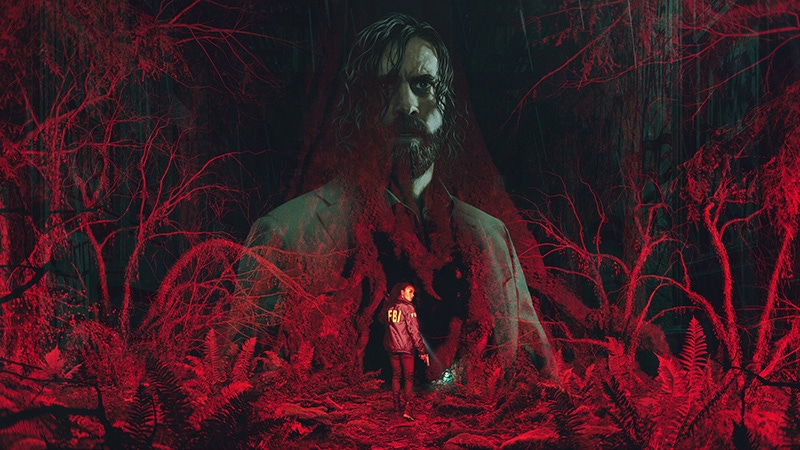Why Alan Wake 2 conjured two protagonists for the survival horror sequel
Alan Wake II game director Sam Lake explains why the titular protagonist isn't the only playable character in this long-awaited sequel.

The much-anticipated sequel to Alan Wake will see its titular protagonist return to face another ordeal against the forces of darkness. But the tormented writer's fight for survival is not the only story to be told in the sequel; he'll share the spotlight with new protagonist: FBI agent Saga Anderson, who will have her own ordeal with the darkness.
With Alan Wake II being Remedy's first true survival horror game and stepping further into the Remedy Connected Universe alongside 2019's Control, it's clear that the sequel has more ambitious plans for the follow-up to the original cult favorite. Alan Wake II features two protagonists and a twin narrative structure, a bold idea for a sequel to a fan-favorite property that Remedy Entertainment has been trying to get off the ground for some time.
At Summer Game Fest, I saw an extended developer-led preview of an early chapter of the game focusing on Saga's first encounters with the dark forces at work in Bright Falls. Creative director Sam Lake also shared some insights with Game Developer about how this revival of the Alan Wake series aims to lean further into quirky and meta-storytelling while putting its spin on survival horror.
Returning to Alan Wake’s fictional town of Bright Falls
"It's a unique approach; we have two separate narrative threads running beside each other with two different characters," said Remedy Entertainment creative director Sam Lake. "And yet, they are very much connected in mysterious and surprising ways, echoing and mirroring each other."
What's interesting about Alan Wake II's twin narrative is that the full game will have storylines for Alan and Saga, and players can switch between them at their choosing. During the presentation, the developers described it as a non-linear approach to a narrative-driven survival horror game. You're not committed to one story for its entire duration, but rather, you can crisscross between them to see important story beats, which will reveal information in the other.
The main story of Alan Wake II picks up 13 years after the original—the same amount of time since its release. As FBI agent Saga Anderson investigates a series of murders in Bright Falls with ties to Robert Nightingale, the main antagonist in the previous game, she finds herself thrust into a battle against the very dark forces that Alan Wake fought years prior. After traversing through a dense forest filled with specters and illusions, she makes contact with Alan Wake, who has finally escaped the Dark Place after 13 years.
Saga Anderson is an interesting character for the Alan Wake series, like Remedy's take on Clarice Starling from The Silence of the Lambs. From the extended preview, we saw her face the bizarre and unsettling reality of Bright Falls and the dark forces at work. She shares a habit of inner commentary like with Alan, but she's far more analytical in her perspective. It really sold how unsettling it was to be thrust into this world as a "newcomer." With the focus on a twin narrative, Saga's storyline is an interesting foil for Alan's perspective as a writer struggling with the creative process.

It's an intriguing approach to a survival horror game, which leans into the meta-level storytelling that the previous Alan Wake did so well. According to Sam Lake, this approach isn't a gimmick but rather highlights the game's larger aspirations for its horror narrative that has commentary on the act of storytelling.
"There is a method to our madness, and this structure is a big part of the mystery you are pursuing in the game. We wanted the player to decide in which order they experience these two story threads; they are free to do it in any way they want, and it will still work. There is no wrong or right way. We hope this will also encourage players to replay the experience in a different order. From a design perspective, this means that we do not have twists and cliffhangers across the two threads for the majority of the game, even if we have them inside each thread."
Alan Wake II is going for bigger scares than its predecessor
When the game was revealed, Sam Lake stated that Alan Wake II would be Remedy's “first true survival horror experience,” and the preview shown at Summer Game Fest proved that. While the original was a horror game, it leaned heavily on action-horror and tons of combat encounters. The sequel, however, goes for more purposeful horror combat encounters and resource management, similar to games like Resident Evil 2 Remake or The Evil Within. It even features a grid-based inventory menu.
In the demo, Saga's descent into the forest around Bright Falls saw her engage with possessed foes in combat and some light puzzle-solving sequences. An incredibly moody and tense environment filled with jump scares spooked the entire audience watching the devs play.
Much like in the original game, Alan Wake II uses light as an offensive tool in combat, with the player blasting enemies with their flashlight to stun them and finishing them off with firearms. According to Sam Lake, what Alan Wake II brings to the survival horror genre is a more prosperous focus on atmosphere and storytelling, which are common strengths of Remedy's games.
"When it comes to atmosphere and combat, Alan Wake II is very much a survival horror game with a focus on surviving with light against the forces of supernatural darkness, but the game is much more as well," he said. "It's a very ambitious story-focused experience with a deep and layered mystery where the story is tightly woven into gameplay."
During one of the demo's most grotesque moments, Saga finds a mutilated torso with a crumpled-up piece of paper inside, which details locations from the original game's ending. In Alan Wake II, there's a deep focus on investigation and gaining knowledge.
One of the game's biggest features is that Saga, and presumably, Alan as well, can fall back to her "mind palace." It's a special safe area that looks like her office, which functions as an explorable "menu" to look over your investigation and examine a physical manifestation of Saga's inner psyche.
This safe place can be pulled up at nearly any time throughout the game, and during the demo the developer ventured into Saga's mind palace seamlessly during one of the game's missions in the forest. In this space, Saga can examine an investigation board to look at clues, make connections in her case, upgrade weapons, and review lore. Even though it's a safe space for Saga to sit in, it's still an eerie space to inhabit.

What I found interesting about Alan Wake II is that it's a survival horror experience with a puzzle box element, similar to shows like True Detective, Mr. Robot, and obviously Twin Peaks. It's an intriguing take on survival horror, adding a more profound sense of mystery and eeriness to a grotesque, unnerving experience. As Sam Lake said when looking at the game's horror structure, he stated it's not about being a relentless horror experience but rather building up an atmosphere that will keep players surprised at what's to come.
"Beyond this, Alan Wake II is not a wall-to-wall horror experience—you are not always in darkness fighting monsters. There are daytime missions as well, where you get to explore the majestic wilderness of the Pacific Northwest and meet the quirky locals in the small towns of Bright Falls and Watery. There is plenty of humor in it as well. We feel that this will guarantee that the horror parts of this will stay fresh and surprising all the way to the end."
Remedy's last game Control will play a part in the Alan Wake sequel
With Alan Wake II, Remedy Entertainment is stepping back into an established world that has gotten bigger thanks to their last hit game Control. With Control, the developers created their own connected universe, which saw Alan Wake make a cameo in a DLC story. According to Sam Lake, Alan Wake II will pick up some ideas from Control and apply them to this expanded take on their horror IP.
"We always want to take learnings from previous games to the next one. The more open, hub-like structure of Control was a big influence for the structure of Alan Wake II," he said. "We started to experiment with vision-like, stylized live-action content in Control, and we have taken that, and the art-house horror stylization overall much further in Alan Wake II.
"Finally, we were excited to build a weird setting in Control, and after receiving a lot of positive feedback for it, we do have similar elements hidden in Alan Wake II for the players to discover as Alan Wake and Control are part of the same 'Remedy Connected Universe.'"
Alan Wake II takes some bold swings at revitalizing a classic from Remedy's cult favorite. This re-invention of the series retains the self-aware storytelling and tense atmosphere but dips further into a survival horror experience that plays with perspective for its duo protagonist, and that could be just what the series needs for it to hit its mark for its long-awaited return.
Read more about:
FeaturesAbout the Author
You May Also Like









